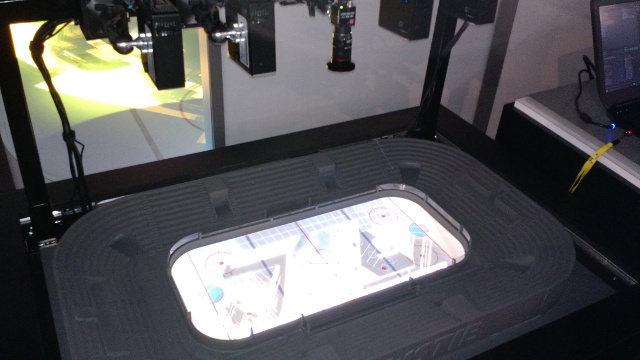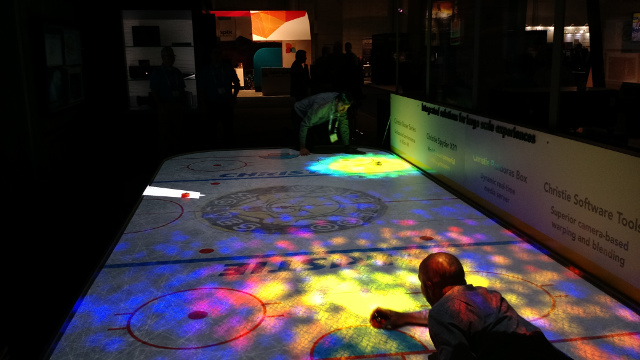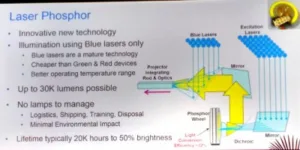Laser phosphor light sources have a limited lifetime in cinema projection. That was the message that Christie’s Cinema Manager, Don Shaw, delivered at the Future of Cinema conference sponsored by NAB and organized by SMPTE. That’s why Christie is ‘all in’ for RGB laser projection and predicts that by 2022, all new cinema projectors will be RGB laser models. Shaw was careful to note that this is for the cinema segment, not the broader projection market.
That’s a pretty bold statement for an industry that is experiencing rapid change. In his presentation, he started by noting the key elements of a great image: brightness, contrast, color and resolution. Last July, DCI issued revised recommendations on the recommended practice for 3D projection due to the availability of RGB laser projectors. There are now two levels of projection at screen center for 3D mode:
- Xenon, Mercury and Laser Phosphor solutions – 7 ± 2 fL
- RGB Laser solution – 14 ± 2 fL at screen center
In terms of color gamut, xenon, mercury and laser phosphor can all achieve the required DCI P3 color gamut, but with various levels of efficiency. Xenon has a nice broad spectrum, but mercury and laser phosphor sources are red deficient. That means a yellow notch filter is need to get better isolation of the red light. But this wastes a lot of light (a 30-40% loss in most systems seeking to achieve a DCI-P3 color space) and generates a lot of heat. RGB lasers don’t have to use a yellow notch filter, so are much more efficient.
Overall, Shaw sees Xenon lamps as able to serve all but the premium part of the cinema market due to its 2D brightness limitation of around 35K lumens, limited brightness in 3D mode, relatively high power consumption and étendue challenges for achieving HDR performance levels.
Mercury lamps have longer lifetimes and lower costs than xenon lamps, but they are much less optically efficient due to the yellow notch filter. Colors change with age and they are more prone to spontaneous explosions. Shaw says that as a result, they are more suitable for “less discerning cinema audiences.”
Surprisingly, Shaw says that a large percentage of exhibitors actually remove the yellow notch filter to get more brightness out of the projector. This clearly means the movie is not running in the required DCI-P3 color space, but exhibitors don’t seem to care.
Shaw says that he was initially really excited about laser phosphor technology features including long lifetime, use of mature blue lasers, reduced maintenance and better overall TCO. But he now sees the weaknesses for the cinema market.

The Achilles’ heel is in the area of efficiency and lifetime. The light conversion efficiency of the yellow phosphor wheel is about 32%, but you have to now add a yellow notch filter to take away more light. The result is very poor optical efficiency (around 19% overall) which shows up as added heat and cooling requirements. With a lifetime specified at 20K hours to 50% brightness, this equates to 5.5 years of operation for theaters that run 10 hours per day, or 3.7 years of operation for theaters running 15 hours per day. While this may not seem that bad, Shaw says that exhibitors expect more with this level of investment.
And, like the mercury lamp solution, vendors are removing the yellow notch filter in the field to get more brightness. His conclusion: laser phosphor solutions make sense if the theater is not heavily operated, if the quality of the presentation can suffer a bit or where the projector is remotely located and hard to access.
Finally, Shaw turned to the RGB laser solution, which solves all of the problems except one: cost. RGB laser projection can enable the highest lumen venue, high brightness 3D, a 2020 color gamut, long life time, high efficiency and low power consumption, and a small etendue for high dynamic range. There is no need for a yellow notch filter, either.
The big issue, cost, is going to come down more quickly than people think, said Shaw. He noted that the current lasers require a lot of liquid cooling but in the lab, they are working on lasers that can be air cooled with fans. This will eliminate the expensive chillers and help drive down costs. Air cooled laser is the approach that Power Technologies uses, as GM, Walter Burgess, pointed out to me during Shaw’s presentation.
Shaw also says Christie has direct emitting green lasers they are working on with four times the efficiency of the frequency-doubled solutions used today.
All of these factors led to the prediction shown in the chart below. By 2022, all new cinema projectors will be RGB laser. -CC


